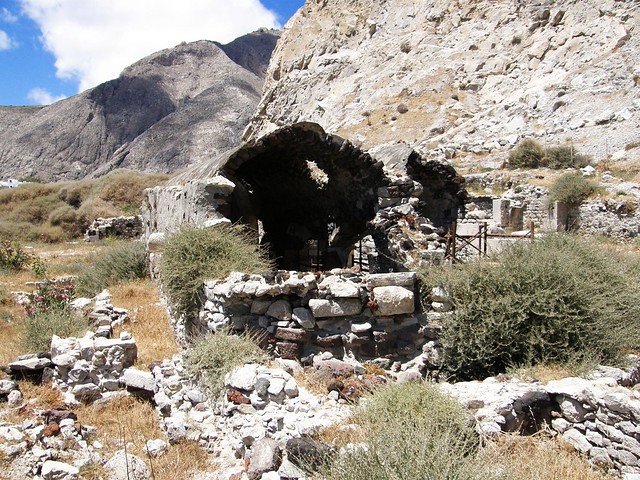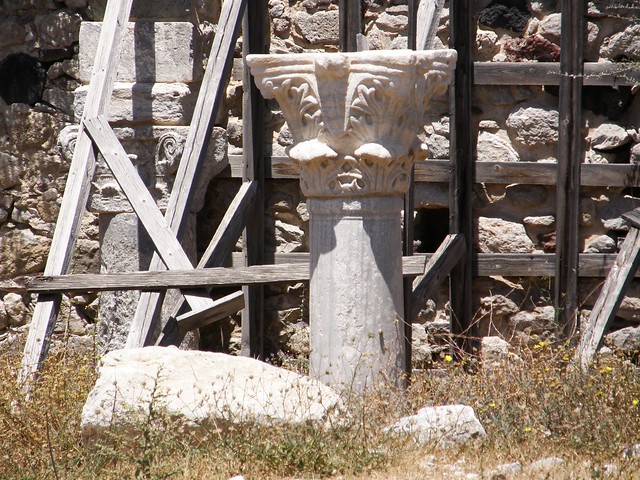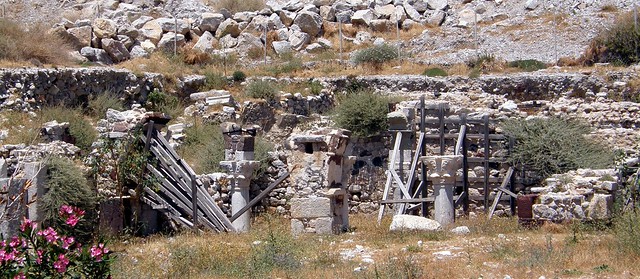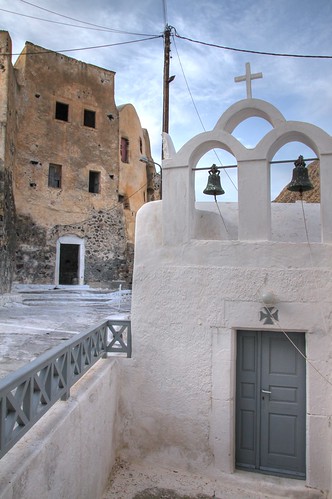

ΜεσοΒυζαντινός ναός της Αγίας Ειρήνης, Περίσσα / Middle Byzantine church of St. Irene
Santa Irene
Για χρόνια υπήρχε η άποψη ότι ο λόγος που οι Ενετοί ονόμασαν το νησί "Σαντορίνη" ήταν η ύπαρξη μικρής εκκλησίας της Αγίας Ειρήνης στην Θηρασιά... Κάτι τέτοιο, βέβαια, θα ήταν περίεργο, καθώς οι Ενετοί θαλασσοπόροι δεν μπορεί να μην καταλάβαιναν ότι Θηρασιά και Σαντορίνη είναι δύο διαφορετικά νησιά...
Τα δεδομένα άλλαξαν το 1992, όταν η 2η Εφορεία Βυζαντινών Αρχαιοτήτων άρχισε εργασίες υποστήλωσης σε Μεσοβυζαντινό (8ου με 9ου αιώνα) δίκλιτο ερειπωμένο ναό της Αγίας Ειρήνης που βρισκόταν στους πρόποδες του Μέσα Βουνού. Κάτω από τον ναό αυτό ανακαλύφθηκαν τα ερείπια Παλαιοχριστιανικής Βασιλικής της Αγίας Ειρήνης, η κατασκευή της οποίας χρονολογείται από τα τέλη του 5ου αιώνα, ενώ φαίνεται να υπήρξε και δεύτερη οικοδομική φάση κατά το δεύτερο μισό του 6ου αιώνα. Ήταν τρίκλιτη βασιλική με μήκος μεσαίου κλίτους 25 μέτρα. Το αναταλικό μέρος του μεσαίου κλίτους του Παλαιοχριστιανικού ναού είχε χρησιμοποιηθεί για την οικοδόμηση του μεσοβυζαντινού.
Η πλήρης αποκάλυψη της βασιλικής, της οποίας το δάπεδο βρίσκεται σήμερα σε βάθος 2 μέτρων, θα απαιτήσει αρκετά χρόνια ανασκαφικής δραστηριότητας. Θεωρείται ότι είναι όμοια με την Βασιλική του Αγίου Απολλινάριου της Ραβένας με έτος κτίσεως το 493 μ.Χ., η οποία είχε κτιστεί με χρήματα του Έλληνα τραπεζίτη Ιούλιου Αργεντάριου.
Τα δεδομένα άλλαξαν το 1992, όταν η 2η Εφορεία Βυζαντινών Αρχαιοτήτων άρχισε εργασίες υποστήλωσης σε Μεσοβυζαντινό (8ου με 9ου αιώνα) δίκλιτο ερειπωμένο ναό της Αγίας Ειρήνης που βρισκόταν στους πρόποδες του Μέσα Βουνού. Κάτω από τον ναό αυτό ανακαλύφθηκαν τα ερείπια Παλαιοχριστιανικής Βασιλικής της Αγίας Ειρήνης, η κατασκευή της οποίας χρονολογείται από τα τέλη του 5ου αιώνα, ενώ φαίνεται να υπήρξε και δεύτερη οικοδομική φάση κατά το δεύτερο μισό του 6ου αιώνα. Ήταν τρίκλιτη βασιλική με μήκος μεσαίου κλίτους 25 μέτρα. Το αναταλικό μέρος του μεσαίου κλίτους του Παλαιοχριστιανικού ναού είχε χρησιμοποιηθεί για την οικοδόμηση του μεσοβυζαντινού.
Η πλήρης αποκάλυψη της βασιλικής, της οποίας το δάπεδο βρίσκεται σήμερα σε βάθος 2 μέτρων, θα απαιτήσει αρκετά χρόνια ανασκαφικής δραστηριότητας. Θεωρείται ότι είναι όμοια με την Βασιλική του Αγίου Απολλινάριου της Ραβένας με έτος κτίσεως το 493 μ.Χ., η οποία είχε κτιστεί με χρήματα του Έλληνα τραπεζίτη Ιούλιου Αργεντάριου.

ΠαλαιόΧριστιανικός Ναός της Αγίας Ειρήνης / Early Christian church of St. Irene, Perissa
Η αρχαία Ελευσίνα
Έχει διατυπωθεί η άποψη ότι η Περίσσα βρίσκεται στην θέση της αρχαίας πόλης της Ελευσίνας, η οποία αναφέρεται από τον Πτολεμαίο τον Γεωγράφο ως μία από τις πόλεις της Σαντορίνης. Ευρήματα που αποδεικνύουν ότι στην Περίσσα υπήρχε αρχαία πόλη έχουν βρεθεί ήδη από το 1836, κατά την διάρκεια ανασκαφών. Πάνω στα ερείπια της αρχαίας αυτής πόλης οικοδομήθηκε κατά τους βυζαντινούς χρόνους άλλη πόλη, η οποία πρέπει να ήταν ιδιαίτερα πλούσια, κάτι που αποδεικνύεται και από την ύπαρξη των ερειπίων της τρίκλιτης βασιλικής της Αγίας Ειρήνης. Η πόλη εκτιμάται ότι έφτασε σε παρακμή κατά την διάρκεια της βασιλείας του Λεόντα Γ΄ του Ίσαυρου. Πιθανότατα η παρακμή της πόλης να σχετίζεται είτε άμεσα με την ηφαιστειακή έκρηξη του 726 μ.Χ. στην Παλαιά Καμένη, είτε έμμεσα εξαιτίας της συμμετοχής των κατοίκων στην επανάσταση του 727 μ.Χ. εναντίον του εικονομάχου αυτοκράτορα ως δείγμα θεϊκής οργής κατά του οποίου θεωρήθηκε η έκρηξη.

ΠαλαιόΧριστιανικός Ναός της Αγίας Ειρήνης / Early Christian church of St. Irene, Perissa
Η έκρηξη του 726 μ.Χ.
Το 726 μ.Χ. σημειώθηκε έκρηξη στη βορειοανατολική πλευρά της Παλαιάς Καμένης. Από την λάβα της έκρηξης δημιουργήθηκε ένα νησί το οποίο γρήγορα ενώθηκε με την Παλαιά Καμένη και έτσι διαμορφώθηκε αυτό που σήμερα αποκαλούμε "Λάβες του Αγίου Νικολάου" (σήμερα τμήμα της Παλαιάς Καμένης). Η έκρηξη θεωρήθηκε ως δείγμα θεϊκής οργής κατά του Αυτοκράτορα του Βυζαντίου Λέοντος Γ' του Ίσαυρου, ο οποίος ήταν εικονομάχος. Οι αντίπαλοι του αυτοκράτορα χρησιμοποίησαν το γεγονός για να υποκινήσουν εξέγερση, η οποία τελικά εκδηλώθηκε το 727, τόσο στις Κυκλάδες όσο και στην υπόλοιπη Ελλάδα. Αρχηγός της επανάστασης ήταν ο τουρμάρχης της Ελλάδας Αγαλλιανός και ο Στέφανος. Οι επαναστάτες όρισαν άλλο αυτοκράτορα, έναν Κρητικό που ονομαζόταν Κοσμάς, και πλεύσανε προς την Κωνσταντινούπολη. Ο στόλος καταστράφηκε από το υγρό πυρ, στις 18 Απριλίου του 727, ενώ από τους αρχηγούς της επαναστάσεως, ο μεν Αγαλλιανός ρίχτηκε στην θάλασσα, οι δε Στέφανος και Κοσμάς παραδόθηκαν και αποκεφαλίσθηκαν.

Αγία Θεοδοσία, Εμπορειό / St. Theodosia, Emporio
Σαντορίνη και Εικονολατρεία
Η ισχυρή τοποθέτηση των κατοίκων της Σαντορίνης υπέρ της εικονολατρείας και εναντίον της εικονομαχίας φαίνεται και από το γεγονός ότι έξω από την πύλη κάθε καστελιού του νησιού υπάρχει εκκλησία της Αγίας Θεοδοσίας της οσιομάρτυρος. Η Αγία Οσιομάρτυρας Θεοδοσία καταγόταν από τήν Κωνσταντινούπολη. Όταν έμεινε ορφανή από πατέρα, σε ηλικία επτά ετών, έγινε μοναχή. Κατά την διάρκεια της βασιλείας του Λέοντα Γ΄του Ίσαυρου (717 – 741 μ.Χ.) εξαπολύθηκε άγριος διωγμός εναντίον των εικονόλατρών και των ιερών εικόνων, ενώ ο τότε Πατριάρχης Γερμανός αντικαταστάθηκε από τον εικονομάχο Αναστάσιο. Κατά την έναρξη του διωγμού διετάχθει από τον αυτοκράτορα η καθαίρεση και καταστροφή της εικόνας του Χριστού που βρισκόταν στην Χαλκή Πύλη. Τότε η Θεοδοσία, επικεφαλής καλογριών και άλλων γυναικών, όρμησαν καὶ κατέρριψαν από την κινητή σκάλα τον σπαθάριο που ανέβηκε γιά να καταστρέψει την εικόνα, και με πέτρες και ξύλα επετέθησαν κατά του Πατριαρχείου. Μπροστά σε αυτή την κατάσταση ο Πατριάρχης Αναστάσιος αναγκάσθηκε να εγκαταλείψει το Πατριαρχείο. Επενέβη στρατιωτική δύναμη και η Θεοδοσία συνελήφθη. Αργότερα κακοποιήθηκε και δολοφονήθηκε μαρτυρικά (730 μ.Χ.).
[ENG] Santa Irene: For years it was believed that the reason why Venetians named the island "Santorini" was because of the small church of Agia Irini that is located on Thirassia island. This would have been strange, though, since Venetian navigators obviously new that Santorini and Thirassia were two different islands. Things changed in 1992, when the 2nd Byzantine Archaeological Council started working on supporting a Middle Byzantine (8th-9th century AD) church of St. Irene that was at the foot of "Mesa Vouno" (the mountain on the top of which Ancient Thera is located). Under this church, the ruins of a magnificent Early Christian Basilica of St. Irene were discovered. The construction of this older church dates back to the late fifth century, while it seems that there was a second building phase in the second half of the sixth century. Full disclosure of the basilica, the floor of which is now at a depth of 2 meters, will require several years of excavation activity. The basilica is considered to be similar to the Basilica of Sant' Apollinare in Classe of Ravenna, which was built in the year 493 AD with the money of the Greek banker Julianus Argentarius. Ancient Eleusis: It has been suggested that Perissa is located where the ancient city of Eleusis was located. Eleusis was mentioned by the ancient geographer Ptolemy as one of the cities of the island. Archaeological findings show that, during the Byzantine period, on the ruins of this ancient city, another city was built. It must have been very rich, something that it is evidenced also by the existence of the ruins of the basilica of St. Irene. It is believed that the city's decline started during the reign of the Byzantine emperor Leo III. Perhaps the decline of the city is related either directly to the volcanic eruption of the 726 AD in Palea Kameni island, or indirectly due the involvement of the residents of Santorini in the revolution of 727 AD against the iconoclast emperor. The volcanic explosion was seen by people of Santorini as a sign of divine wrath against the emperor. The explosion of 726 AD: In 726 AD there was an explosion in the northeastern part of Palea Kameni. The lava created an island that soon joined Palaia Kameni island. The explosion was seen as a sign of divine wrath against the Byzantine Emperor Leo III, who was iconoclast. Opponents of the emperor used the event to incite rebellion, which finally started in 727 AD, both in the Cyclades and the rest of Greece. Leaders of the Revolution was the tourmarches of Greece, Agallianos, and Stefanos. The rebels named a Cretan called Kosmas as emperor and set sails to Constantinople (today Istanbul). The fleet of the rebels was destroyed by the so-called "Greek fire" on 18 April 727, Agallianos was thrown into the sea, while Stefanos and Kosmas were beheaded. Santorini and Iconolatry: The strong position of the inhabitants of Santorini in favor of iconolatry and against iconoclasm is evident by the fact that outside the gates of all the fortified settlements of the islands there is always a church of St. Theodosia the Martyr. St. Theodosia was born in Constantinople. When she become orphan by her father, in the age of seven, she became a nun. During the reign of Leo III (717 to 741 AD) a fierce persecution against iconolatry was unleashed, while the Patriarch German was replaced by Anastasius, who was an iconoclast. At the beginning of the persecution, the Emperor ordered the destruction of the image of Christ which was above the Bronze Gate of Constantinople. Theodosia, together with other nuns, threw from the movable staircase the soldier who was ordered to destroy the image, and with stones and sticks attacked the Patriarchate. Faced with this situation, the Patriarch Anastasius left the Patriarchate. Troops intervened and arrested Theodosia. Later, she was molested, tortured and murdered (730 AD).

Αγία Θεοδοσία, Εμπορειό / St. Theodosia, Emporio
Σαντορίνη και Εικονολατρεία
Η ισχυρή τοποθέτηση των κατοίκων της Σαντορίνης υπέρ της εικονολατρείας και εναντίον της εικονομαχίας φαίνεται και από το γεγονός ότι έξω από την πύλη κάθε καστελιού του νησιού υπάρχει εκκλησία της Αγίας Θεοδοσίας της οσιομάρτυρος. Η Αγία Οσιομάρτυρας Θεοδοσία καταγόταν από τήν Κωνσταντινούπολη. Όταν έμεινε ορφανή από πατέρα, σε ηλικία επτά ετών, έγινε μοναχή. Κατά την διάρκεια της βασιλείας του Λέοντα Γ΄του Ίσαυρου (717 – 741 μ.Χ.) εξαπολύθηκε άγριος διωγμός εναντίον των εικονόλατρών και των ιερών εικόνων, ενώ ο τότε Πατριάρχης Γερμανός αντικαταστάθηκε από τον εικονομάχο Αναστάσιο. Κατά την έναρξη του διωγμού διετάχθει από τον αυτοκράτορα η καθαίρεση και καταστροφή της εικόνας του Χριστού που βρισκόταν στην Χαλκή Πύλη. Τότε η Θεοδοσία, επικεφαλής καλογριών και άλλων γυναικών, όρμησαν καὶ κατέρριψαν από την κινητή σκάλα τον σπαθάριο που ανέβηκε γιά να καταστρέψει την εικόνα, και με πέτρες και ξύλα επετέθησαν κατά του Πατριαρχείου. Μπροστά σε αυτή την κατάσταση ο Πατριάρχης Αναστάσιος αναγκάσθηκε να εγκαταλείψει το Πατριαρχείο. Επενέβη στρατιωτική δύναμη και η Θεοδοσία συνελήφθη. Αργότερα κακοποιήθηκε και δολοφονήθηκε μαρτυρικά (730 μ.Χ.).
[ENG] Santa Irene: For years it was believed that the reason why Venetians named the island "Santorini" was because of the small church of Agia Irini that is located on Thirassia island. This would have been strange, though, since Venetian navigators obviously new that Santorini and Thirassia were two different islands. Things changed in 1992, when the 2nd Byzantine Archaeological Council started working on supporting a Middle Byzantine (8th-9th century AD) church of St. Irene that was at the foot of "Mesa Vouno" (the mountain on the top of which Ancient Thera is located). Under this church, the ruins of a magnificent Early Christian Basilica of St. Irene were discovered. The construction of this older church dates back to the late fifth century, while it seems that there was a second building phase in the second half of the sixth century. Full disclosure of the basilica, the floor of which is now at a depth of 2 meters, will require several years of excavation activity. The basilica is considered to be similar to the Basilica of Sant' Apollinare in Classe of Ravenna, which was built in the year 493 AD with the money of the Greek banker Julianus Argentarius. Ancient Eleusis: It has been suggested that Perissa is located where the ancient city of Eleusis was located. Eleusis was mentioned by the ancient geographer Ptolemy as one of the cities of the island. Archaeological findings show that, during the Byzantine period, on the ruins of this ancient city, another city was built. It must have been very rich, something that it is evidenced also by the existence of the ruins of the basilica of St. Irene. It is believed that the city's decline started during the reign of the Byzantine emperor Leo III. Perhaps the decline of the city is related either directly to the volcanic eruption of the 726 AD in Palea Kameni island, or indirectly due the involvement of the residents of Santorini in the revolution of 727 AD against the iconoclast emperor. The volcanic explosion was seen by people of Santorini as a sign of divine wrath against the emperor. The explosion of 726 AD: In 726 AD there was an explosion in the northeastern part of Palea Kameni. The lava created an island that soon joined Palaia Kameni island. The explosion was seen as a sign of divine wrath against the Byzantine Emperor Leo III, who was iconoclast. Opponents of the emperor used the event to incite rebellion, which finally started in 727 AD, both in the Cyclades and the rest of Greece. Leaders of the Revolution was the tourmarches of Greece, Agallianos, and Stefanos. The rebels named a Cretan called Kosmas as emperor and set sails to Constantinople (today Istanbul). The fleet of the rebels was destroyed by the so-called "Greek fire" on 18 April 727, Agallianos was thrown into the sea, while Stefanos and Kosmas were beheaded. Santorini and Iconolatry: The strong position of the inhabitants of Santorini in favor of iconolatry and against iconoclasm is evident by the fact that outside the gates of all the fortified settlements of the islands there is always a church of St. Theodosia the Martyr. St. Theodosia was born in Constantinople. When she become orphan by her father, in the age of seven, she became a nun. During the reign of Leo III (717 to 741 AD) a fierce persecution against iconolatry was unleashed, while the Patriarch German was replaced by Anastasius, who was an iconoclast. At the beginning of the persecution, the Emperor ordered the destruction of the image of Christ which was above the Bronze Gate of Constantinople. Theodosia, together with other nuns, threw from the movable staircase the soldier who was ordered to destroy the image, and with stones and sticks attacked the Patriarchate. Faced with this situation, the Patriarch Anastasius left the Patriarchate. Troops intervened and arrested Theodosia. Later, she was molested, tortured and murdered (730 AD).








1 comment:
Παρακαλώ θα ήθελα να μάθω περισσότερες πληροφορίες,τόσο για την εξέλιξη της ανασκαφής όσο και για το στάδιο υποστήλωσης ή αναστήλωσης του βυζαντινού ναού της Αγίας Ειρήνης και ό,τι άλλο γνωρίζετε σχετικά.Ψάχνοντας,βρήκα πως πρόκειται για την μεγαλομάρτυρα Αγία Ειρήνη,αφού χρονολογικά,σε εκείνη ταιριάζει να είναι αφιερωμένος ο ναός,καθώς έζησε τον 4ο αιώνα.Σας ευχαριστώ εκ των προτέρων και καλή συνέχεια στις δημοσιεύσεις σας.
Post a Comment